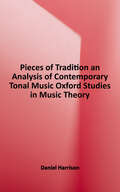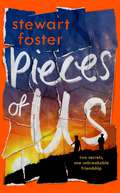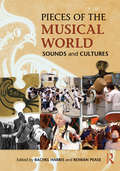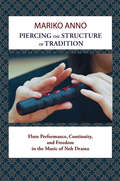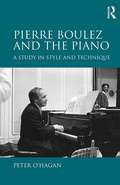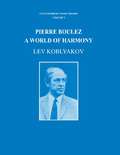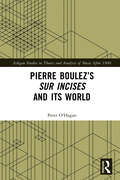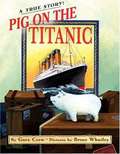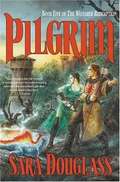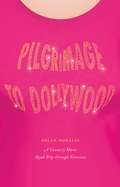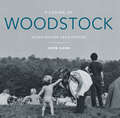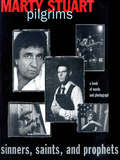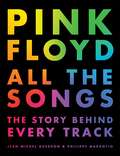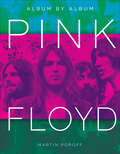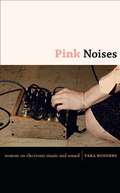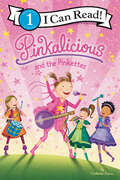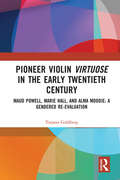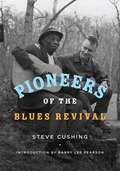- Table View
- List View
Pieces of My Heart: A Life
by Robert J. Wagner Scott EymanThe Hollywood icon tells about his rise to Hollywood stardom among legends like Cary Grant and Barbara Stanwyck and his troubled marriage, divorce, and remarriage to starlet Natalie Wood.In the revelation-filled memoir from one of Hollywood’s most talented actors, readers have a candid and deeply personal look at the life and career of Robert Wagner. Wagner’s long career began in the Hollywood of the 1950s, when studios were dominant and even the love lives of actors were dictated by what benefited the studio. His memoirs will chronicle in a very personal way his rise to stardom, his decline, and his resurrection. Wagner will talk candidly about his famous relationship with Natalie Wood and the circumstances surrounding her tragic death. His friendships and stories include major Hollywood personalities in the last half of the 20th century.When his family moved to Los Angeles, a young Wagner held a variety of jobs (including one as a caddy for Clark Gable) while pursuing his goal, but it was while dining with his parents at a restaurant in Beverly Hills that he was “discovered” by a talent scout.Known as much for his on-screen abilities as his off-screen personal heartbreak, Wagner will discuss for the first time his complicated and ultimately tragic relationship with Hollywood sweetheart Natalie Wood. It was implied that Wagner played a role in Natalie Wood’s tragic drowning off the coast of Catalina Island in 1981 and Wagner, for the first time ever, will set the record straight.With at least two dozen photos to illustrate his real Hollywood-style tell-all, this will be the extremely candid autobiography of Robert Wagner.
Pieces of Tradition: An Analysis of Contemporary Tonal Music
by Daniel HarrisonThis book is about how music "in a key" is composed. Further, it is about how such music was composed when it was no longer compulsory to do so, starting a few years before the First World War. In an eclectic journey through the history of compositional technique, Daniel Harrison contends that the tonal system did not simply die out with the dawn of the twentieth century, but continued to supplement newer techniques as a compelling means of musical organization, even into current times. Well-known art music composers such as Bartok, Hindemith, Prokofiev, and Messiaen are represented alongside composers whose work moves outside the standard boundaries of art music: Leonard Bernstein, Murice Durufle, Frank Martin, Xiaoyong Chen. Along the way, the book attends to military bugle calls, a trailer before a movie feature, a recomposition of a famous piece by Arnold Schoenberg, and the music of Neil Diamond, David Shire, and Brian Wilson. A celebration of the awesome variety of musical expressions encompassed in what is called tonal music, Pieces of Tradition is a book for composers seeking ideas and effects, music theorists interested in its innovations, and all those who practice the analysis of composition in all its modern and traditional variations.
Pieces of Us
by Stewart FosterTwo secrets, an unbreakable bond . . . a powerful and heartbreaking love letter to a life-changing friendship, from award-winning author, Stewart Foster. I wish you were here, because maybe this isn&’t a story, or a diary. Perhaps it&’s just the longest thank you letter a friend could ever write. As the summer before college begins, Jonas is hiding a secret. He suffers with bulimia, but no one knows. Not even he knows how bad it really is. Until he meets Louis, a confident dreamer who believes in a better future for Jonas and together they enjoy a sun-kissed summer filled with music, memories and life-changing moments. But when tragedy strikes, Jonas must decide if he has the strength to face things alone . . . Writing from personal experience, an award-winning author shines an important light on difficult themes of illness, mental health, and grief in a redemptive story of friendship, for readers of Meg Rosoff and Sarah Crossan. Warning: contains some themes that readers may find upsetting, including disordered eating.
Pieces of Why
by K. L. GoingFrom the award winning author of Fat Kid Rules the World and The Liberation of Gabriel King comes a lyrical, middle grade gem that asks all the hard questions and hits all the right notes--perfect for fans of Cynthia Rylant and Mockingbird by Kathryn ErskineTia lives with her mom in a high-risk neighborhood in New Orleans and loves singing gospel in the Rainbow Choir with Keisha, her boisterous and assertive best friend. Tia's dream is to change the world with her voice; and by all accounts, she might be talented enough. But when a shooting happens in her neighborhood and she learns the truth about the crime that sent her father to prison years ago, Tia finds she can't sing anymore. The loss prompts her to start asking the people in her community hard questions--questions everyone has always been too afraid to ask.Full of humanity, Pieces of Why is a timely story that addresses grief, healing, and forgiveness, told through the eyes of a gifted girl who hears rhythm and song everywhere in her life.dcover edition.
Pieces of Why
by K. L. GoingFrom the award winning author of Fat Kid Rules the World and The Liberation of Gabriel King comes a lyrical, middle grade gem that asks all the hard questions and hits all the right notes--perfect for fans of Cynthia Rylant and Mockingbird by Kathryn ErskineTia lives with her mom in a high-risk neighborhood in New Orleans and loves singing gospel in the Rainbow Choir with Keisha, her boisterous and assertive best friend. Tia's dream is to change the world with her voice; and by all accounts, she might be talented enough. But when a shooting happens in her neighborhood and she learns the truth about the crime that sent her father to prison years ago, Tia finds she can't sing anymore. The loss prompts her to start asking the people in her community hard questions--questions everyone has always been too afraid to ask.Full of humanity, Pieces of Why is a timely story that addresses grief, healing, and forgiveness, told through the eyes of a gifted girl who hears rhythm and song everywhere in her life.
Pieces of the Musical World: Sounds and Cultures
by Rachel Harris Rowan PeasePieces of the Musical World: Sounds and Cultures is a fieldwork-based ethnomusicology textbook that introduces a series of musical worlds each through a single "piece." It focuses on a musical sound or object that provides a springboard from which to tell a story about a particular geographic region, introducing key aspects of the cultures in which it is embedded, contexts of performance, the musicians who create or perform it, the journeys it has travelled, and its changing meanings. A collaborative venture by staff and research ethnomusicologists associated with the Department of Music at SOAS, University of London, Pieces of the Musical World is organized thematically. Three broad themes: "Place", "Spirituality" and "Movement" help teachers to connect contemporary issues in ethnomusicology, including soundscape studies, music and the environment, the politics of identity, diaspora and globalization, and music and the body. Each of the book's fourteen chapters highlights a single musical "piece" broadly defined, spanning the range of "traditional," "popular", "classical" and "contemporary" musics, and even sounds which might be considered "not music." Primary sources and a web site hosting recordings with interactive listening guides, a glossary of musical terms and interviews all help to create a unique and dynamic learning experience of our musical world.
Piercing the Structure of Tradition: Flute Performance, Continuity, and Freedom in the Music of Noh Drama
by Mariko AnnoWhat does freedom sound like in the context of traditional Japanese theater? Where is the space for innovation, and where can this kind of innovation be located in the rigid instrumentation of the Noh drama? In Piercing the Structure of Tradition, Mariko Anno investigates flute performance as a space to explore the relationship between tradition and innovation. This first English-language monograph traces the characteristics of the Noh flute (nohkan), its music, and transmission methods and considers the instrument's potential for development in the modern world. Anno examines the musical structure and nohkan melodic patterns of five traditional Noh plays and assesses the degree to which Issō School nohkan players maintain to this day the continuity of their musical traditions in three contemporary Noh plays influenced by Yeats. Her ethnographic approach draws on interviews with performers and case studies, as well as her personal reflection as a nohkan performer and disciple under the tutelage of Noh masters. She argues that traditions of musical style and usage remain influential in shaping contemporary Noh composition and performance practice, and the existing freedom within fixed patterns can be understood through a firm foundation in Noh tradition.
Pierre Boulez Studies
by Edward Campbell Peter O’haganPierre Boulez is acknowledged as one of the most important composers in contemporary musical life. This collection explores his works, influence, reception and legacy, shedding new light on Boulez's music and its historical and cultural contexts. In two sections that focus firstly on the context of the 1940s and 1950s and secondly on the development of the composer's style, the contributors address recurring themes such as Boulez's approach to the serial principle and the related issues of form and large-scale structure. Featuring excerpts from Boulez's correspondence with a range of his contemporaries here published for the first time, the book illuminates both Boulez's relationship with them and his thinking concerning the challenges which confronted both him and other leading figures of the European avant-garde. In the final section, three chapters examine Boulez's relationship with audiences in the United Kingdom, and the development of the appreciation of his music.
Pierre Boulez and the Piano: A Study in Style and Technique
by Peter O'HaganPierre Boulez's first piano pieces date from his youth, prior to his studies in Paris with Messiaen, and his subsequent meteoric rise to international acclaim as the leader of the musical avant-garde during the 1950s. His most recent published work is a solo piano piece, Une page d’éphéméride, written some sixty years after his first attempts at composition. The piano has remained central to Boulez's creative work throughout his career, and although his renown as a conductor has to some extent overshadowed his other achievements, it was as a performer of his own piano music that his practical gifts first found expression. Peter O'Hagan has given performances of various unpublished piano works by Boulez, including Antiphonie from the Third Sonata and Trois Psalmodies. In this study, he considers Boulez's writing for the piano in the context of the composer's stylistic evolution throughout the course of his development. Each of the principal works is considered in detail, not only on its own terms, but also as a stage in Boulez's ongoing quest to invent radical solutions to the renewal of musical language and to reinvigorate tradition. The volume includes reference to hitherto unpublished source material, which sheds light on his working methods and on the interrelationship between works.
Pierre Boulez: A World of Harmony (Contemporary Music Studies #2)
by Lev KoblyakovFirst published in 1994. Routledge is an imprint of Taylor & Francis, an informa company.
Pierre Boulez’s sur Incises and its World (Ashgate Studies in Theory and Analysis of Music After 1900)
by Peter O'HaganPerformer and researcher Peter O’Hagan studies the musical style of Pierre Boulez during his final creative period, by means of a detailed consideration of the ensemble work sur Incises, which stands at the heart of Boulez’s later output.O’Hagan offers a unique blend of perceptions stemming from playing as well as analysing Boulez’s piano music. It is examined in the context of the group of works based on the cipher derived from the name of the dedicatee, Paul Sacher. With one exception, these works are dominated by the keyboard, and sur Incises is examined in relation both to them and to the composer’s output as a whole. An absorbing narrative elucidates the complex evolution of sur Incises, informed by a study of the considerable body of sketches and drafts. O’Hagan sheds new light on the creative process, not only in this work, but more generally on Boulez as a dominant force in music since 1950.The book will be of interest not only to specialists in the field of contemporary music but to musicology students and a wider public interested in the work of one of the dominating creative personalities of our time.
Pietro Von Abano (Selected Works of Louis Spohr, 1784-1859 #3)
by Clive BrownVolume 3 of the SELECTED WORKS OF Louis Spohr 1784-1859- Pietro von Abano. At about this time one of his pupils, the twenty-three-year-old Carl Friedrich Curschmann, who had ambitions to compose an opera, showed Spohr a libretto that had been adapted from Ludwig Tieck's novel Pietro von Abano oder Petrus Apone, eine Zaubergeschichte (Breslau 1825) by the Kassel lawyer and poet Carl Pfeiffer. Spohr was immediately impressed by the libretto and, having dissuaded Curschmann from going ahead with the project, probably on the grounds that he was too inexperienced for such a major undertaking, he came to an agreement with Curschmann and Pfeiffer that he should set it himself. Including the plot, script and screenshots of the original music documents.
Pig on the Titanic: A True Story
by Gary CrewA pig on a passenger liner? Impossible! No! No! It's me ... Maxixe, the music box pig! Everyone knows the story of the night the great ship Titanic sank. But few know the story of Maxixe, one of the unsung heroes of that night, and how this small musical pig soothed the fears of a lifeboat full of children. Based on true events, this dramatic story by author Gary Crew is told through the charming and compassionate voice of Maxixe.
Pilgrim
by Sara DouglassIn this massive series now drawing to a close, Ms. Douglass imagines a world where three races, demons and men from the future all figure. This is the fifth of six books.
Pilgrimage to Dollywood: A Country Music Road Trip Through Tennessee
by Helen MoralesA star par excellence, Dolly Parton is one of country music’s most likable personalities. Even a hard-rocking punk or orchestral aesthete can’t help cracking a smile or singing along with songs like "Jolene” and "9 to 5. ” More than a mere singer or actress, Parton is a true cultural phenomenon, immediately recognizable and beloved for her talent, tinkling laugh, and steel magnolia spirit. She is also the only female star to have her own themed amusement park: Dollywood in Pigeon Forge, Tennessee. Every year thousands of fans flock to Dollywood to celebrate the icon, and Helen Morales is one of those fans. In Pilgrimage to Dollywood, Morales sets out to discover Parton’s Tennessee. Her travels begin at the top celebrity pilgrimage site of Elvis Presley’s Graceland, then take her to Loretta Lynn’s ranch in Hurricane Mills; the Country Music Hall of Fame and the Grand Ole Opry in Nashvil≤ to Sevierville, Gatlinburg, and the Great Smoky Mountains National Park; and finally to Pigeon Forge, home of the "Dolly Homecoming Parade,” featuring the star herself as grand marshall. Morales’s adventure allows her to compare the imaginary Tennessee of Parton’s lyrics with the real Tennessee where the singer grew up, looking at essential connections between country music, the land, and a way of life. It’s also a personal pilgrimage for Morales. Accompanied by her partner, Tony, and their nine-year-old daughter, Athena (who respectively prefer Mozart and Miley Cyrus), Morales, a recent transplant from England, seeks to understand America and American values through the celebrity sites and attractions of Tennessee. This celebration of Dolly and Americana is for anyone with an old country soul who relies on music to help understand the world, and it is guaranteed to make a Dolly Parton fan of anyone who has not yet fallen for her music or charisma.
Pilgrims of Woodstock: Never-Before-Seen Photos
by John KaneIntimate portraits by photojournalist Richard F. Bellak of the musical festival&’s counterculture attendees celebrating peace, love, and rock and roll. In the summer of 1969, 400,000 people from across the country came together and redefined the music scene forever. Though the legacy and lore of Woodstock lives on in the memory of its attendees, a new generation can experience the real and unedited festival through Richard Bellak&’s never-before-seen photographs and John Kane&’s incredible new interviews.Pilgrims of Woodstock offers a vivid and intimate portrait of the overlooked stars of the festival: the everyday people who made Woodstock unforgettable. The photographs and interviews capture attendees&’ profound personal moments across hundreds of acres of farmland, as they meditated, played music, cooked food at night, and congregated around campfires. For three days, they helped and relied on each other in peace and harmony. For most, it was a life-changing event. Now, after the 50th anniversary of the famed festival, relive their experiences firsthand in Pilgrims of Woodstock.
Pilgrims: Sinners, Saints, and Prophets
by Marty StuartMarty Stuart, one of the most popular country artists, portrays well-known and not-so-well-known pilgrims through spectacular photographs and well-written words. Marty portrays in the book "a life that ain't easy, but one that I understand".
Pimps Up, Ho's Down: Hip Hop's Hold on Young Black Women
by T. Denean Sharpley-WhitingUntangles the intricately knotted issues around hip-hop culture and its treatment of young black womenPimps Up, Ho’s Down pulls at the threads of the intricately knotted issues surrounding young black women and hip hop culture. What unravels for Tracy D. Sharpley-Whiting is a new, and problematic, politics of gender. In this fascinating and forceful book, Sharpley-Whiting, a feminist writer who is a member of the hip hop generation, interrogates the complexities of young black women's engagement with a culture that is masculinist, misogynistic, and frequently mystifying.Beyond their portrayal in rap lyrics, the display of black women in music videos, television, film, fashion, and on the Internet is indispensable to the mass media engineered appeal of hip hop culture, the author argues. And the commercial trafficking in the images and behaviors associated with hip hop has made them appear normal, acceptable, and entertaining - both in the U.S. and around the world.Sharpley-Whiting questions the impacts of hip hop's increasing alliance with the sex industry, the rise of groupie culture in the hip hop world, the impact of hip hop's compulsory heterosexual culture on young black women, and the permeation of the hip hop ethos into young black women's conceptions of love and romance.The author knows her subject from the inside. Coming of age in the midst of hip hop's evolution in the late 1980s, she mixed her graduate studies with work as a runway and print model in the 1990s. Her book features interviews with exotic dancers, black hip hop groupies, and hip hop generation members Jacklyn “Diva” Bush, rapper Trina, and filmmaker Aishah Simmons, along with the voices of many “everyday” young women.Pimps Up, Ho’s Down turns down the volume and amplifies the substance of discussions about hip hop culture and to provide a space for young black women to be heard. 2007 Popular Culture Association/American Culture Association Emily Toth Award
Pink Floyd All the Songs: The Story Behind Every Track (All The Songs)
by Jean-Michel Guesdon Philippe MargotinThe newest addition to the best-selling All the Songs series details the unique recording history of Pink Floyd, one of the world's most commercially successful and influential rock bands.Since 1965, Pink Floyd been recording sonically experimental and philosophical music, selling more than 250 million records worldwide, including two of the best-selling albums of all time Dark Side of the Moon and The Wall. While much is known about this iconic group, few books provide a comprehensive history of their time in the studio. In Pink Floyd All the Songs, authors Margotin and Guesdon describe the origin of their nearly 200 released songs, details from the recording studio, what instruments were used, and behind-the-scenes stories of the tensions that helped drive the band.Organized chronologically by album, this massive, 544-page hardcover begins with their 1967 debut album The Piper at the Gates of Dawn, the only one recorded under founding member Syd Barrett's leadership; through the loss of Barrett and the addition of David Gilmour; to Richard Wright leaving the band in 1979 but returning; to Roger Waters leaving in 1985 and the albums recorded since his departure, including their 2014 farewell album, The Endless River, which was downloaded 12 million times on Spotify the week it was released. Packed with more than 500 photos, All the Songs is also filled with stories fans treasure, such as Waters working with engineer Alan Parsons to employ revolutionary recording techniques for The Dark Side of the Moon at Abbey Road Studios in 1972 or producer Bob's Ezrin's contribution in refining Water's original sprawling vision for The Wall.
Pink Floyd Shine On: The Definitive Oral History
by Mark BlakeThe definitive oral history of Pink Floyd as told by friends, associates, family members and the band themselves through exclusive, never before published interviews.Bestselling music author Mark Blake has been an associate and collaborator of Pink Floyd for over thirty years. Shine On takes on the behemoth task of capturing the most comprehensive history of the band ever compiled, drawing on huge amounts of new, archive and unpublished interview material with Gilmour, Waters, Mason and Wright. No other writer has interviewed the members of Pink Floyd as often nor as thoroughly, which is candidly apparent in this textured, gripping and consistently surprising biography. For the first time, the band's story is told as an oral history with each chapter presented through the words the band, their friends, contemporaries and supporting musicians. The accessible structure and high level of detail means that the narrative is both approachable to casual readers and magnetic to the committed.Shine On is comprised of a significant amount of previously unpublished material, including a rare interview with Rosemary Breen lamenting that her younger brother Roger, aka Syd Barrett, should have never become a musician as well as exclusive new interviews with the band and their associates, reflecting on their enduring legacy and rather more complicated recent twists and turns in the bands story.Shine On is a skilful retelling of one of the most turbulent and enduring groups in rock music history, a complex history that only someone as skilled and insightful as Blake can navigate.
Pink Floyd: Album by Album (Album by Album)
by Martin PopoffAn in-depth discography filled with facts, photos, and conversations with musicians, rock journalists, and fans of the band.This stunning look back at Pink Floyd’s discography comprises a series of in-depth, frank, and entertaining conversations about all of the band’s studio albums, including their soundtrack efforts and the instrumental/ambient The Endless River. Inside, prolific rock journalist Martin Popoff moderates discussions on each album with rock journalists and musicians who offer insights, opinions, and anecdotes about every release.Together, the conversations comprise a unique historical overview of the band, covering everything from early albums with the iconic Syd Barrett to the songwriting tandem of Roger Waters and David Gilmour; the impeccable talents of drummer Nick Mason and multi-instrumentalist Richard Wright; those mega tours undertaken in support of the LPs; the monster success of breakthrough LP Dark Side of the Moon; interpersonal conflict; the band following Waters’ 1985 departure; and much more. Popoff also includes sidebars that provide complete track listings, album personnel, and studios and dates. Every page is illustrated with thoughtfully curated performance and offstage photography, as well as rare memorabilia.Praise for Martin Popoff“Popoff has a lyrical way with words.” —Publishers Weekly
Pink Noises: Women on Electronic Music and Sound
by Tara RodgersPink Noises brings together twenty-four interviews with women in electronic music and sound cultures, including club and radio DJs, remixers, composers, improvisers, instrument builders, and installation and performance artists. The collection is an extension of Pinknoises. com, the critically-acclaimed website founded by musician and scholar Tara Rodgers in 2000 to promote women in electronic music and make information about music production more accessible to women and girls. That site featured interviews that Rodgers conducted with women artists, exploring their personal histories, their creative methods, and the roles of gender in their work. This book offers new and lengthier interviews, a critical introduction, and resources for further research and technological engagement. Contemporary electronic music practices are illuminated through the stories of women artists of different generations and cultural backgrounds. They include the creators of ambient soundscapes, "performance novels," sound sculptures, and custom software, as well as the developer of the Deep Listening philosophy and the founders of the Liquid Sound Lounge radio show and the monthly Basement Bhangra parties in New York. These and many other artists open up about topics such as their conflicted relationships to formal music training and mainstream media representations of women in electronic music. They discuss using sound to work creatively with structures of time and space, and voice and language; challenge distinctions of nature and culture; question norms of technological practice; and balance their needs for productive solitude with collaboration and community. Whether designing and building modular synthesizers with analog circuits or performing with a wearable apparatus that translates muscle movements into electronic sound, these artists expand notions of who and what counts in matters of invention, production, and noisemaking. Pink Noises is a powerful testimony to the presence and vitality of women in electronic music cultures, and to the relevance of sound to feminist concerns. Interviewees: Maria Chavez, Beth Coleman (M. Singe), Antye Greie (AGF), Jeannie Hopper, Bevin Kelley (Blevin Blectum), Christina Kubisch, Le Tigre, Annea Lockwood, Giulia Loli (DJ Mutamassik), Rekha Malhotra (DJ Rekha), Riz Maslen (Neotropic), Kaffe Matthews, Susan Morabito, Ikue Mori, Pauline Oliveros, Pamela Z, Chantal Passamonte (Mira Calix), Maggi Payne, Eliane Radigue, Jessica Rylan, Carla Scaletti, Laetitia Sonami, Bev Stanton (Arthur Loves Plastic), Keiko Uenishi (o. blaat)
Pinkalicious and the Pinkettes (I Can Read Level 1)
by Victoria Kann#1 New York Times bestselling author Victoria Kann brings young readers a Pinkalicious I Can Read adventure that celebrates creativity and resourcefulness! Rock out with Pinkalicious and her friends in this Level One I Can Read. Pinkalicious and her friends want to start a band, but they don’t have any instruments! Pinkalicious will need to find a creative answer. When Pinkalicious realizes there are amazing sounds all around, she figures out what to do. Pinkalicious and the Pinkettes is a Level One I Can Read book, which means it’s perfect for children learning to sound out words and sentences. Readers can watch Pinkalicious and Peterrific on the funtastic PBS Kids TV series Pinkalicious & Peterrific!
Pioneer Violin Virtuose in the Early Twentieth Century: Maud Powell, Marie Hall, and Alma Moodie: A Gendered Re-Evaluation
by Tatjana GoldbergTatjana Goldberg reveals the extent to which gender and socially constructed identity influenced female violinists’ ‘separate but unequal’ status in a great male-dominated virtuoso lineage by focussing on the few that stood out: the American Maud Powell (1867–1920), Australian-born Alma Moodie (1898–1943), and the British Marie Hall (1884–1956). Despite breaking down traditional gender-based patriarchal social and cultural norms, becoming celebrated soloists, and greatly contributing towards violin works and the early recording industry (Powell and Hall), they received little historical recognition. Goldberg provides a more complete picture of their artistic achievements and the impact they had on audiences.
Pioneers of the Blues Revival (Music in American Life)
by Steve CushingSteve Cushing, the award-winning host of the nationally syndicated public radio staple Blues before Sunrise, has spent over thirty years observing and participating in the Chicago blues scene. In Pioneers of the Blues Revival, he interviews many of the prominent white researchers and enthusiasts whose advocacy spearheaded the blues' crossover into the mainstream starting in the 1960s. Opinionated and territorial, the American, British, and French interviewees provide fascinating first-hand accounts of the era and movement. Experts including Paul Oliver, Gayle Dean Wardlow, Sam Charters, Ray Flerledge, Paul Oliver, Richard K. Spottswood, and Pete Whelan chronicle in their own words their obsessive early efforts at cataloging blues recordings and retrace lifetimes spent loving, finding, collecting, reissuing, and producing records. They and nearly a dozen others recount relationships with blues musicians, including the discoveries of prewar bluesmen Mississippi John Hurt, Son House, Skip James, and Bukka White, and the reintroduction of these musicians and many others to new generations of listeners. The accounts describe fieldwork in the South, renew lively debates, and tell of rehearsals in Muddy Waters's basement and randomly finding Lightning Hopkins's guitar in a pawn shop. Blues scholar Barry Lee Pearson provides a critical and historical framework for the interviews in an introduction.

